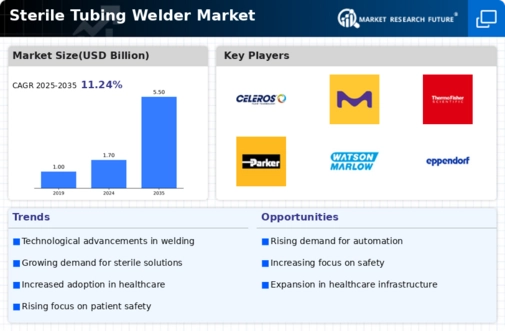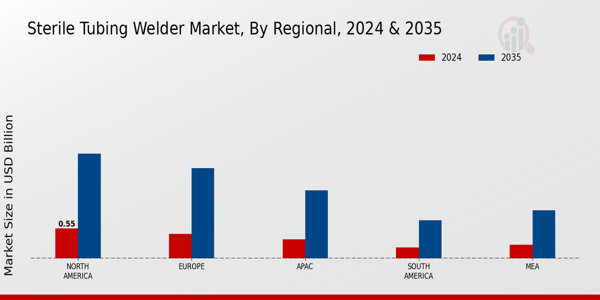Market Trends and Projections
The Global Sterile Tubing Welder Market Industry is characterized by several key trends and projections that highlight its growth trajectory. The market is expected to reach 1.7 USD Billion in 2024, with a significant increase anticipated by 2035, when it could reach 5.5 USD Billion. The compound annual growth rate (CAGR) of 11.26% from 2025 to 2035 indicates a robust expansion driven by technological advancements, regulatory compliance, and the growing biopharmaceutical sector. These trends suggest a dynamic market landscape, where innovation and compliance are crucial for success.
Increasing Regulatory Compliance
The Global Sterile Tubing Welder Market Industry is significantly influenced by the increasing regulatory compliance requirements imposed by health authorities worldwide. Regulatory bodies are enforcing stringent guidelines to ensure that medical devices meet safety and efficacy standards. This has led to a heightened demand for sterile tubing welders that can produce devices in compliance with these regulations. Manufacturers are compelled to adopt advanced welding technologies that not only meet but exceed these standards. As a result, the market is poised for substantial growth, with a projected CAGR of 11.26% from 2025 to 2035, reflecting the industry's responsiveness to regulatory pressures.
Growth in Biopharmaceutical Sector
The biopharmaceutical sector's expansion is a significant driver for the Global Sterile Tubing Welder Market Industry. As biopharmaceutical companies increasingly focus on developing complex therapies, the need for sterile and efficient fluid transfer systems becomes paramount. Sterile tubing welders are essential in ensuring the integrity of bioprocessing operations, which often involve sensitive biological materials. The growth of this sector is expected to propel the market forward, as companies seek reliable solutions to maintain sterility throughout the production process. This trend aligns with the overall growth trajectory of the market, which is anticipated to reach 5.5 USD Billion by 2035.
Emerging Markets and Global Expansion
Emerging markets present a significant opportunity for the Global Sterile Tubing Welder Market Industry. As healthcare infrastructure improves in developing regions, there is an increasing demand for advanced medical technologies, including sterile tubing welders. Countries in Asia-Pacific and Latin America are witnessing rapid growth in healthcare investments, leading to a surge in the adoption of sterile medical devices. This expansion is likely to drive the market's growth, as manufacturers seek to establish a presence in these regions. The overall market dynamics indicate a robust growth potential, with projections suggesting a CAGR of 11.26% for the period from 2025 to 2035.
Rising Demand for Sterile Medical Devices
The Global Sterile Tubing Welder Market Industry experiences a notable increase in demand for sterile medical devices, driven by the growing emphasis on patient safety and infection control. Hospitals and healthcare facilities are increasingly adopting sterile tubing welders to ensure the integrity of fluid transfer systems. This trend is particularly pronounced in regions with stringent regulatory standards for medical device manufacturing. As a result, the market is projected to reach 1.7 USD Billion in 2024, reflecting the industry's commitment to enhancing safety protocols. The rising prevalence of chronic diseases further fuels this demand, necessitating advanced medical technologies that ensure sterility.
Technological Advancements in Welding Equipment
Technological advancements play a pivotal role in shaping the Global Sterile Tubing Welder Market Industry. Innovations in welding technology, such as automated and semi-automated systems, enhance efficiency and precision in the manufacturing process. These advancements not only reduce the risk of contamination but also improve the overall quality of medical devices. Manufacturers are increasingly investing in research and development to integrate smart technologies, such as IoT connectivity, into their welding systems. This trend is expected to contribute to the market's growth, with projections indicating a rise to 5.5 USD Billion by 2035. Enhanced operational capabilities may lead to a more streamlined production process.














